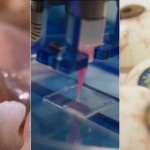
At the dawn of rapid prototyping, a common predication was that 3D printing would transform manufacturing, spurring a consumer revolution that would put a printer in every home. That hasn’t quite happened—-and like so many emerging technologies, rapid prototyping has found its foothold in a surprisingly different field: Medicine.
The following studies and projects represent some of the most fascinating examples of "bioprinting," or using a computer-controlled machine to assemble biological matter using organic inks and super-tough thermoplastics. They range from reconstructing major sections of skull to printing scaffolding upon which stem cells can grow into new bones.
Skulls

Osteofab is a product made by a British company called Oxford Performance Materials. OPM got into the business by selling a high-performance polymer often used in medical implants—a thermoplastic called polyetherketoneketone—in raw form. But over the past few years, the company has also pioneered the application of the stuff, primarily through additive manufacturing. In February, an American patient received an FDA-approved skull patch made of the material, which had been carefully molded and printed to fit 75 percent of his unique skull geometry. [Osteofab]
Skin

A big problem with the idea of "printing" new skin is how difficult it is to recreate a particular skin tone in every kind of light: Because our skin is so unique, thin, and mutable, it’s hard to perfect an exact replica. There are too many interesting studies to discuss in a short paragraph, but two highlights: Wake Forest scientist James Yoo is working on machine that can actually print skin directly onto burn victims as part of a DoD-funded grant, while scientists at University of Liverpool are using carefully-calibrated 3D scanners they’re using to capture samples of each subject’s existing skin, which allows them to print a more accurate patch.
The research is ongoing, but the team plans to create a "skin database" of the captured samples, which could be tapped into from remote hospitals without the cameras needed to capture a subject’s own skin. [Gizmodo; PhysOrg]
Noses and Ears

Creating prosthetic ears, noses, and chins are often a painful, expensive, and laborious experience for patient and doctor both. A UK industrial designer named Tom Fripp has spent the past few years collaborating with University of Sheffield scientists to 3D print a cheaper, easier-to-make facial prosthetic. Their process involves 3D scanning a patient’s face (much less invasive than casting it), modeling a replacement part, and printing it using pigment, starch, and medical grade silicone.
An added bonus: When the prosthetic wears out (inevitably, they do), the part can be cheaply re-printed. [The Guardian]
Eyes

Last week, Fripp and the team at Sheffield unveiled the results of testing the same process—on eyes. Prosthetic eyes are expensive to make, since they’re hand-painted, and can often take months to complete. Fripp’s printer can turn out 150 eyes an hour—and the details, like iris color, size, and blood vessels, can be easily customized based on each patient’s needs. [PhysOrg]
Medical Implants

As electronic devices—from drones to medical implants—get smaller, scientists have struggled to manufacture batteries small enough to power them. But a team of Harvard engineers is 3D printing microscopic batteries that are as small as a piece of sand. The team explains:
… the researchers created an ink for the anode with nanoparticles of one lithium metal oxide compound, and an ink for the cathode from nanoparticles of another. The printer deposited the inks onto the teeth of two gold combs, creating a tightly interlaced stack of anodes and cathodes. Then the researchers packaged the electrodes into a tiny container and filled it with an electrolyte solution to complete the battery.
They could eventually power medical implants—like these ones—that are being held up by power issues. [Harvard]
Bones

3D-printed implants—like jawbones—have been around for several years. But a handful of researchers are experimenting with printing actual replacement bones. For example, a University of Nottingham scientist named Kevin Shakeshaff has developed a bioprinter that creates a scaffold of polylactic acid and gelatinous alginate—which is then coated in adult stem cells. According to Forbes, the scaffolding will dissolve and be replaced by new bone growth within roughly three months. [Forbes]
Blood Vessels and Cells

We may be able to print organs, but part of the problem with these manufactured tissue is creating a functioning circulatory system to go with it. Günter Tovar, a German scientist who heads up the Fraunhofer Institute for Interfacial Engineering and Biotechnology, is leading a project called BioRap that’s developing 3D-printed blood vessels using a mix of synthetic polymers and biomolecules. These printed systems are being tested in animals—they aren’t yet ready for humans—but they could eventually enable printed organ transplants. [Fraunhofer Institute]
Source: Gizmodo.com